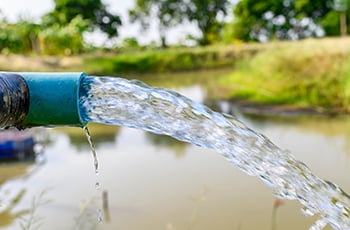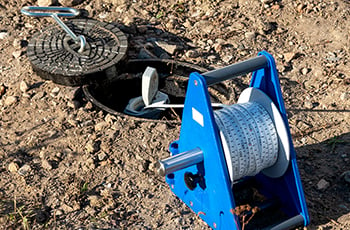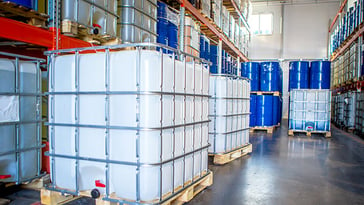
At Haley & Aldrich, we recognize that our society’s environmental issues are always changing; therefore, we need to develop new tools and methods to address emerging issues. Through our Applied Research program, we’re proactively addressing future challenges by testing new ideas and solutions. Our research is resulting in new technologies and processes co-developed with our academic partners and technology suppliers that benefit our clients, industry, and most importantly, the environment. We are deploying these new technologies and processes in the field with our clients so they can ultimately achieve their goals more efficiently and effectively.
By collaborating with government agencies such as the Strategic Environmental Research and Development Program (SERDP) and Environmental Security Technology Certification Program (ESTCP) as well as university research centers, including the Center for Bio-mediated and Bio-inspired Geotechnics (CBBG), our Applied Research experts solve problems, take risks, and generate creative solutions that minimize costs and shorten our clients’ project timelines. Industry and academia also benefit from the resulting innovations, which advance the state of the practice overall.
Learn more about our Applied Research program through the project descriptions and links below.
Project Highlights
Advancing monitoring techniques for abiotic transformation of chlorinated solvent compounds
 This project could revolutionize monitoring methods for the abiotic transformation of chlorinated solvent compounds in subsurface environments. Funded by SERDP and led by Senior Technical Expert, Environmental Engineering Min-Ying Jacob Chu, Ph.D., P.E.; and Raul Tenorio, Ph.D., EIT; in collaboration with Weile Yan, Ph.D., of the University of Massachusetts, Lowell, it aims to develop a cutting-edge monitoring tool capable of demonstrating the occurrence of abiotic transformation and estimating its rate in situ.
This project could revolutionize monitoring methods for the abiotic transformation of chlorinated solvent compounds in subsurface environments. Funded by SERDP and led by Senior Technical Expert, Environmental Engineering Min-Ying Jacob Chu, Ph.D., P.E.; and Raul Tenorio, Ph.D., EIT; in collaboration with Weile Yan, Ph.D., of the University of Massachusetts, Lowell, it aims to develop a cutting-edge monitoring tool capable of demonstrating the occurrence of abiotic transformation and estimating its rate in situ.
Aerobic cometabolic biodegradation of 1,4-dioxane
This ESTCP-funded project aims to demonstrate that recirculation-based aerobic cometabolic biodegradation can be cost-effective for treating deep, large, dilute plumes, which are among the greatest challenges remaining for remediating Department of Defense (DOD) and associated industrial and manufacturing client sites contaminated by chlorinated volatile organic compounds (CVOCs) and 1,4-dioxane. The small-footprint treatment technology will enable installation and save costs on sites with limited access, thereby minimizing the impact of groundwater cleanup on the community while restoring groundwater resources. Chu also leads this project. Read more in the Groundwater Monitoring & Remediation article by Chu and Principal Consultant Peter Bennett.
Assessing polyfluoroalkyl substance transformation in groundwater at aqueous film-forming foam (AFFF)-impacted sites
Environmental Engineering Technical Expert John Xiong, Ph.D., P.E., leads this SERDP-funded project, which aims to develop a reliable in situ method for assessing the rate and extent of the transformation of polyfluoroalkyl substances (also known as precursors or PreFAS) under ambient field conditions using in situ microcosms and stable isotope probing techniques. The researchers will also use the proposed in situ microcosm method to document transformation pathways and indicative biomarkers of the in situ biotransformation of representative PreFAS classes. This technology, when fully developed, would provide a low-cost and readily implementable method for documenting in situ PreFAS transformation and would significantly enhance our ability to understand the ubiquity with which transformation processes occur, the pathway and extent of transformation, and relevant terminal perfluoroalkyl acid transformation products. This technology would also dramatically improve risk assessment and site management decisions for thousands of per- and polyfluoroalkyl substances (PFAS)-impacted sites where precursors are present.
Creating novel in situ subsurface PFAS destruction strategies using ligand-coordinated zero-valent metals at ambient conditions
Xiong collaborates with academic researchers at the University of California, Riverside and the University of Texas at Austin on this project (also funded by SERDP) to develop a cost-effective and efficient in situ method for the destruction of PFAS in groundwater. The project will use ligand-coordinated zero-valent metals (L-M0) immobilized on activated carbon to reductively degrade PFAS pollutants in the subsurface environment. The researchers will optimize and implement innovative L-M0 systems, screen and characterize different L-M0 systems, and evaluate their performance in laboratory and field-scale experiments. Project findings will inform the development of a reactive particulate carbon amendment that can be directly injected into contaminated aquifers, leading to more efficient and sustainable PFAS remediation approaches.
Demonstration of an innovative treatment train for cost-effective removal and destruction of PFAS
Also led by Xiong, this project is funded by the U.S. Air Force Civil Engineer Center and aims to demonstrate an innovative treatment train for the removal and destruction of PFAS in water at a U.S. Air Force site. The treatment train proposed in this effort includes a semicontinuous multistage foam fractionation system to remove (i.e., strip) and concentrate (i.e., enrich) PFAS from the feedwater source (e.g., extracted groundwater) and an ultraviolet (UV)/sulfite-based system to destroy the concentrated PFAS. This innovative treatment train provides the following unique benefits: (1) It is a low-cost treatment solution since a simple process (air bubbles) will be used to remove PFAS; (2) the concentrated PFAS will be effectively destroyed using an advanced reduction process under near-ambient conditions (i.e., no high temperature or high pressure); (3) almost no exhausted media will be generated by this process that would require disposal; (4) the process is relatively simple and easy to operate; and (5) the technology can potentially be applied to thousands of sites impacted by PFAS.
Destruction of PFAS in concentrated waste streams
 The overall objective of this project, funded by ESTCP, is to demonstrate a cost-effective and sustainable chemical reductive technology for the on-site destruction of PFAS in a concentrated waste stream. The technology can also degrade co-occurring chemicals, such as CVOCs. The technology is primarily based on hydrated electrons generated in a UV/sulfite-based system. The project team includes Chu; Xiong; Sarah Mass, M.S., P.E.; Darrin Costantini; Raul Tenorio, Ph.D., EIT; Prachi Jain, M.S.; and researchers at the University of California, Riverside. Read more about this project in our news release. This technology will be available to our clients that are or will potentially be facing challenges remediating PFAS and aims to destroy “forever chemicals,” thereby avoiding energy-intensive and costly incineration options as well as long-term storage options like deep injection.
The overall objective of this project, funded by ESTCP, is to demonstrate a cost-effective and sustainable chemical reductive technology for the on-site destruction of PFAS in a concentrated waste stream. The technology can also degrade co-occurring chemicals, such as CVOCs. The technology is primarily based on hydrated electrons generated in a UV/sulfite-based system. The project team includes Chu; Xiong; Sarah Mass, M.S., P.E.; Darrin Costantini; Raul Tenorio, Ph.D., EIT; Prachi Jain, M.S.; and researchers at the University of California, Riverside. Read more about this project in our news release. This technology will be available to our clients that are or will potentially be facing challenges remediating PFAS and aims to destroy “forever chemicals,” thereby avoiding energy-intensive and costly incineration options as well as long-term storage options like deep injection.
Dye-enhanced laser-induced fluorescence (DyeLIF) probe for mapping dense nonaqueous phase liquids (DNAPLs)
Prior to this research funded by ESTCP, LIF was not able to detect chlorinated solvent DNAPLs. Adrian Fure, Ph.D., P.E., and Contaminated Site Management Service Leader Murray Einarson, P.G., CEG, CHG, developed a new DyeLIF tool in collaboration with Dakota Technologies that is now commercially available and provides rapid, high-resolution subsurface mapping of chlorinated solvent DNAPLs. Its use allows for the development of more effective and expedited removal of groundwater-contaminant sources, thereby shortening the time frame for aquifer restoration. Read more in Einarson’s Groundwater Monitoring & Remediation article.
Enhanced bioremediation with microbial chain elongation (MCE)
CBBG and a Haley & Aldrich client are funding an on-site pilot study to treat groundwater impacted by trichloroethylene (TCE) using the MCE process. Through the careful stepwise addition of food-grade substrates such as acetate and ethanol to the zone of impacted groundwater, the MCE process uses naturally occurring subsurface microbes to create larger organic compounds while releasing hydrogen gas. A different group of naturally occurring microbes then uses the larger compounds and hydrogen gas to reduce TCE in the subsurface to environmentally benign end products. Laboratory studies on site soil and groundwater indicate MCE may also divert hydrogen away from unwanted microbial processes such as methane production. Chu and Bennett are the principal investigators for this project.
Estimation of the biotransformation rate of key PFAS precursors and PFAS sequestration into microbial biomass during precursor biotransformation
Led by Chu, this SERDP-funded project aims to contribute to a better understanding of the site-specific biotransformation rate and extent of PFAS precursors. This understanding is critical to PFAS site management because many terminal biotransformation products are regulated contaminants in drinking water and groundwater. Using an activity-based labeling technique, the team aims to develop a molecular biological tool that can associate useful biomarkers, such as monooxygenases, with the biotransformation rate of key PFAS precursors under conditions relevant to AFFF-impacted sites. They also aim to assess the potential for and extent of sequestration and accumulation of terminal PFAS biotransformation products into microorganisms in the form of intracellular storage polymers.
Improved control of substrate delivery with microbial inhibitors
Chu also serves as the principal investigator for this CBBG-funded project, the overall objective of which is to demonstrate a novel method for controlling microbial processes in space and time for more effective and sustainable aquifer restoration with in situ methods. We are conducting lab studies to see whether inhibitors temporarily deter microbial growth and activity near a substrate injection point. This will allow for more uniform in situ treatment of contaminant plumes to expedite the restoration of groundwater resources.
Optimized numerical models using environmental sequence stratigraphy
This project will develop and publish a practical guide for DOD contractors to evaluate and incorporate advanced geologic models into more efficient, accurate numerical models of groundwater flow and contaminant fate and transport, scaled appropriately for the purpose of the models. With a better understanding of subsurface conditions, remediation systems can be more effectively designed and implemented for more rapid restoration of groundwater resources. The project team includes Einarson; Chu; J.P. Brandenburg, Ph.D.; several environmental software developers; and researchers from Clemson University.
Treatment of hexavalent chromium (Cr VI) using zerovalent iron
Haley & Aldrich is partnering with New Mexico State University’s Dr. Lambis Papelis and his team, which is using iron-modified zeolites to develop an adsorption medium to treat groundwater contaminated by oxyanions of selenium and arsenic. The team’s batch and column sorption experiments have evaluated the efficiency of Cr VI removal under site groundwater conditions. Our principal investigators for this project are Chu and Mass. Following the successful bench-scale testing, Haley & Aldrich is planning to implement a pilot test at a client site.
Utilizing PFAS aggregation at the gas-water interface for energy-efficient PFAS destruction
This SERDP project aims to develop a modified system for UV-reductive treatment (via hydrated electrons) that utilizes the amphipathic properties of PFAS at the gas-water interface to enhance PFAS reductive defluorination and reduce the energy consumption of treatment. Yida Fang, Ph.D., P.E., leads this effort, which focuses on examining the role of different electron donors during foam forming and their impact on PFAS destruction during UV treatment. This project will provide insight into the feasibility of integrating air sparging with existing UV-treatment technologies in a more energy-efficient system for destroying PFAS.

